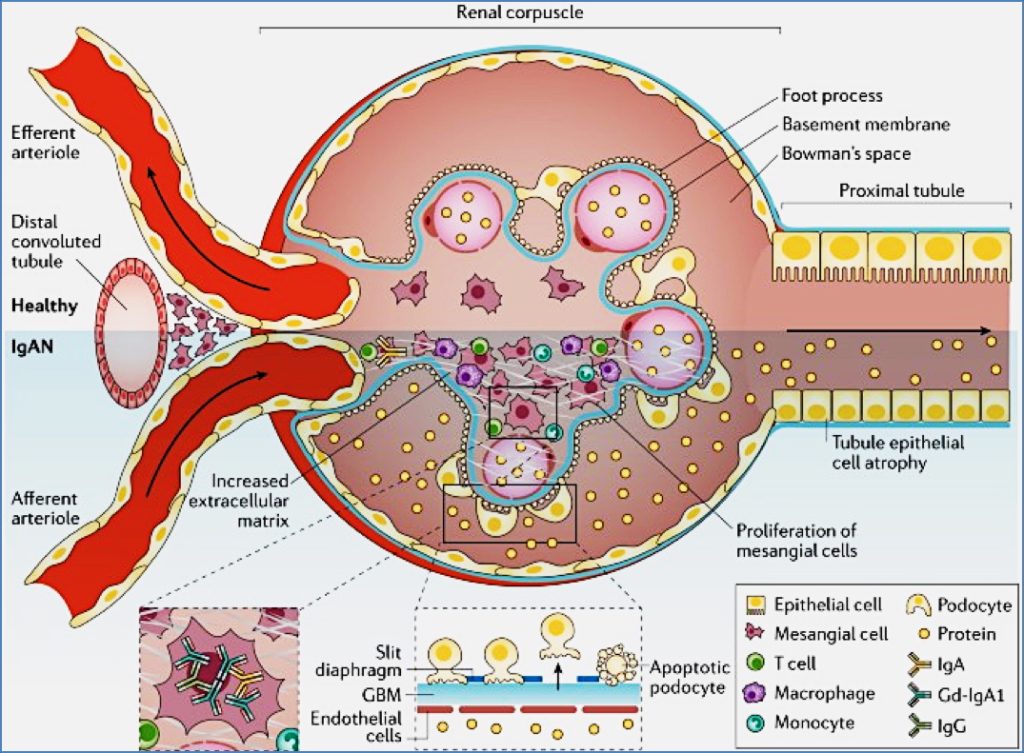Table of Contents
Overview – IgA Nephropathy
IgA nephropathy, also known as Berger’s disease, is the most common cause of nephritic syndrome in young adults aged 15–30 years. It is a chronic glomerulonephritis driven by the autoimmune deposition of IgA-containing immune complexes in the glomerulus, often triggered by mucosal infections. Characteristically, it presents as painless, recurrent haematuria a few days after an upper respiratory tract infection (URTI). While many cases follow a benign course, some progress to chronic kidney disease or renal failure.
Definition
- IgA nephropathy (Berger’s disease) is a chronic glomerular disease characterised by IgA immune complex deposition in the glomeruli.
- It presents as a nephritic syndrome, especially in young adults.
Aetiology
- Autoimmune origin:
- Aberrant IgA immune complexes
- Often triggered by URTIs, gastrointestinal infections, or other mucosal antigen exposures
Pathophysiology
- Abnormal IgA1 glycosylation → forms poorly cleared immune complexes
- Complexes deposit in glomerular mesangium →
- Local inflammation and complement activation
- Glomerular injury
- Red blood cells leak into the urine
- Leads to classic nephritic features

Clinical Features
- Typically affects adolescents and young adults (15–30 years)
- Classic presentation:
- Recurrent, painless macroscopic haematuria
- Appears 3–6 days post-URTI
- Other nephritic syndrome signs:
- Oliguria
- Non-selective proteinuria
- Oedema
- Mild hypertension
Investigations
- Urinalysis:
- Red blood cells and RBC casts
- Serum studies:
- Elevated serum IgA levels (nonspecific but supportive)
- Renal biopsy:
- Gold standard
- Shows mesangial IgA deposits on immunofluorescence
Management
- Corticosteroids:
- Reduce inflammation and suppress abnormal IgA production
- Supportive care:
- Antihypertensives (e.g. ACE inhibitors)
- Proteinuria reduction and blood pressure control
- Monitoring:
- Regular renal function and urine protein follow-up
Complications
- Chronic kidney disease
- End-stage renal failure (in ~10% of cases)
- Around 30% of patients experience slow disease progression
Differential Diagnosis
- Post-streptococcal glomerulonephritis
- Lupus nephritis
- Alport syndrome
- Thin basement membrane disease
- Membranoproliferative glomerulonephritis
Summary – IgA Nephropathy
IgA nephropathy (Berger’s disease) is the leading cause of nephritic syndrome in young adults. It presents with painless haematuria typically following an upper respiratory tract infection. Diagnosis relies on urinalysis, serum IgA, and renal biopsy. Management includes corticosteroids and supportive care. Long-term prognosis varies, with some progressing to renal failure. For a broader context, see our Renal Overview page.